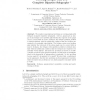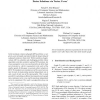95 search results - page 3 / 19 » Covering a hypergraph of subgraphs |
ACL
1998
13 years 8 months ago
1998
Word graphs are able to represent a large number of different utterance hypotheses in a very compact manner. However, usually they contain a huge amount of redundancy in terms of ...
SODA
2004
ACM
13 years 8 months ago
2004
ACM
We consider the problem of finding a sparse set of edges containing the minimum spanning tree (MST) of a random subgraph of G with high probability. The two random models that we ...
FSTTCS
2007
Springer
14 years 1 months ago
2007
Springer
We consider computational problems on covering graphs with bicliques (complete bipartite subgraphs). Given a graph and an integer k, the biclique cover problem asks whether the edg...
AICCSA
2007
IEEE
14 years 1 months ago
2007
IEEE
In the maximum common subgraph (MCS) problem, we are given a pair of graphs and asked to find the largest induced subgraph common to them both. With its plethora of applications,...
ISAAC
2007
Springer
14 years 1 months ago
2007
Springer
The class of graphs where the size of a minimum vertex cover equals that of a maximum matching is known as K¨onig-Egerv´ary graphs. K¨onig-Egerv´ary graphs have been studied ex...


